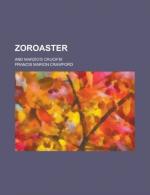Atossa quitted the terrace where she had been talking with Zoroaster, in the full intention of returning speedily, but as she descended the steps, a plan formed itself in her mind, which she determined to put into immediate execution. Instead, therefore, of pursuing her way into the portico of the inner court, when she reached the foot of the staircase, she turned into a narrow passage that led into a long corridor, lighted only by occasional small openings in the wall. A little door gave access to this covered way, and when she entered, she closed it behind her, and tried to fasten it. But the bolt was rusty, and in order to draw it, she laid down the scroll she carried, upon a narrow stone seat by the side of the door; and then, with a strong effort of both her small white hands, she succeeded in moving the lock into its place. Then she turned quickly and hastened down the dusky corridor. At the opposite end a small winding stair led upwards into darkness. There were stains upon the lowest steps, just visible in the half light. Atossa gathered up her mantle and her under tunic, and trod daintily, with a look of repugnance on her beautiful face. The stains were made by the blood of the false Smerdis, her last husband, slain in that dark stairway by Darius, scarcely three months before.
Cautiously the queen felt her way upward till she reached a landing, where a narrow aperture admitted a little light. Higher up there were windows, and she looked carefully to her dress, and brushed away a little dust that her mantle had swept from the wall in passing; and once or twice, she looked back at the dark staircase with an expression of something akin to disgust. At last she reached a door which opened upon a terrace, much like the one where she had left Zoroaster a few moments before, saving that the floor was less polished, and that the spaces between the columns were half filled with hanging plants and creepers. Upon the pavement at one end were spread rich carpets, and half a dozen enormous cushions of soft-coloured silk were thrown negligently one upon the other. Three doors, hung with curtains, opened upon the balcony,—and near to the middle one, two slave-girls, clad in white, crouched upon their heels and talked in an undertone.
Atossa stepped forward upon the marble, and the rustle of her dress and the quick short sound of her heeled shoes, roused the two slave-girls to spring to their feet. They did not know the queen, but they thought it best to make a low obeisance, while their dark eyes endeavoured quickly to scan the details of her dress, without exhibiting too much boldness. Atossa beckoned to one of them to come to her, and smiled graciously as the dark-skinned girl approached.
“Is not thy mistress Nehushta?” she inquired; but the girl looked stupidly at her, not comprehending her speech. “Nehushta,” repeated the queen, pronouncing the name very distinctly with a questioning intonation, and pointing to the curtained door. The slave understood the name and the question, and quick as thought, she disappeared within, leaving Atossa in some hesitation. She had not intended to send for the Hebrew princess, for she thought it would be a greater compliment to let Nehushta find her waiting; but since the barbarian slave had gone to call her mistress, there was nothing to be done but to abide the result.




